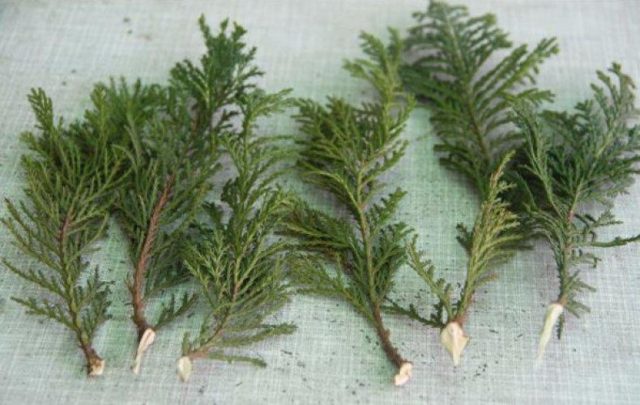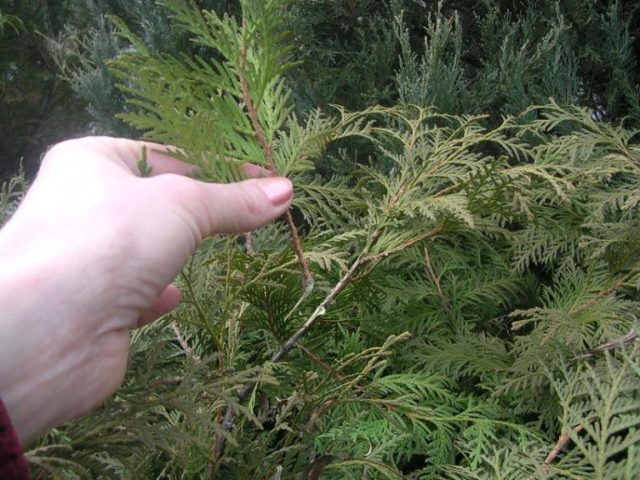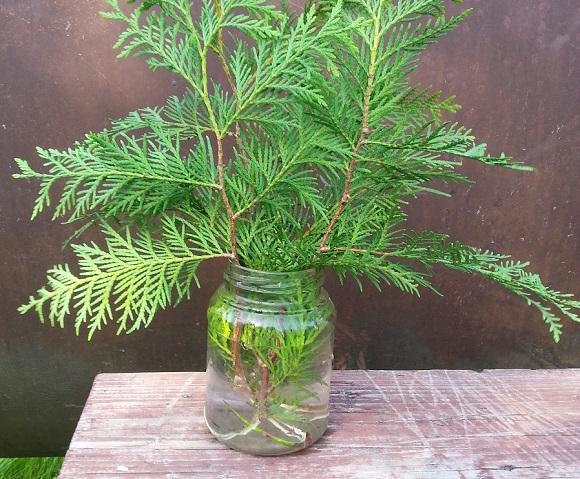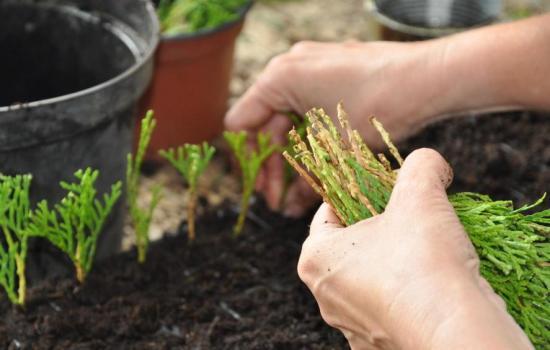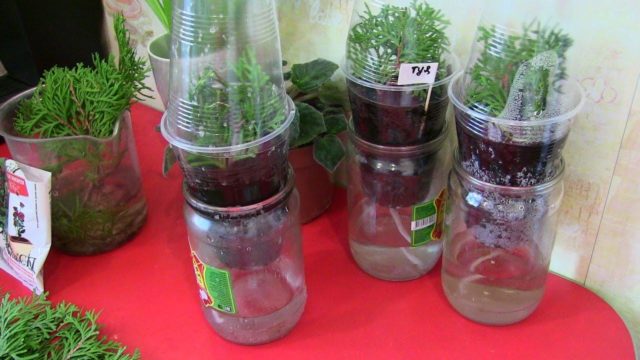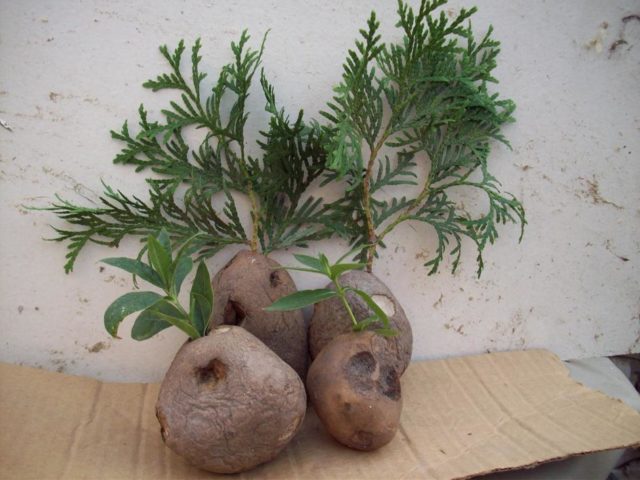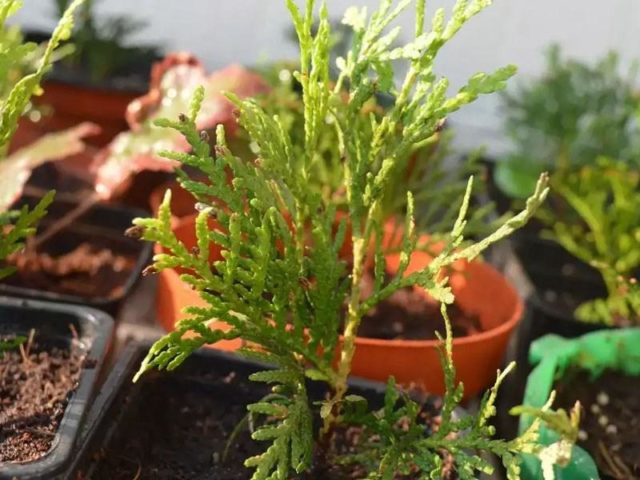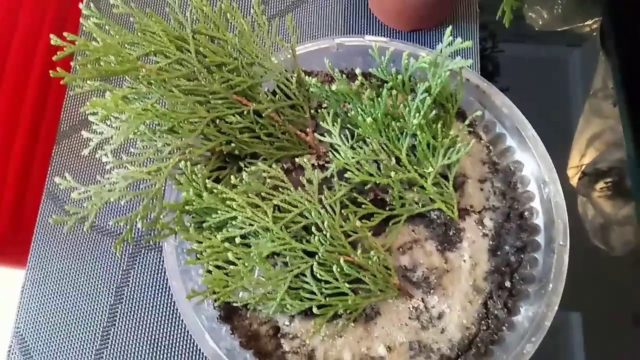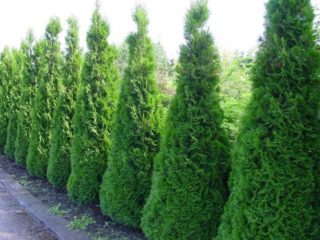Content
Thuja is a small monoecious evergreen tree (less often a shrub) of the Cypress family. This family includes 5 species, which are native to the regions of North America and East Asia. In its natural growing environment, the reproduction of this coniferous culture occurs by seed or vegetative method. However, in nurseries and the garden landscape, thuja are propagated by other methods, one of which is with the help of cuttings. Cutting thuja allows you to significantly save time and effort for germinating seeds, as well as finances for the purchase of a finished seedling.
For everyone who is going to cut an ephedra for the first time, it is important to know all the nuances, rules and features of the cultivation of thuja by cuttings at home.
How thuja reproduces at home
At home, thuyu is often propagated in several ways: for example, you can grow an ephedra from a twig or use the seed method. If propagated by seeds, you can get enough healthy specimens with a high level of endurance in a fairly short time without large financial costs. The seed method allows you to propagate any varieties and types of trees, but this method has a significant disadvantage: the grown seedlings will not correspond to the parental shape by 100%, and may also have deviations in their appearance and decorative qualities. Growing thuja from twigs also has a drawback: with this method of reproduction, no more than 70 - 80% of the plants can survive.
Is it possible to propagate thuja by cuttings
Unlike the seed propagation method, which takes about 6 years, there is another way to breed thuja - cuttings. If you propagate it by cuttings, you can see the result much faster - after 2 - 3 years, when young healthy plants will be obtained, completely suitable for landscaping the garden area. Moreover, seedlings grown from cuttings are much more hardy and viable than propagated by seeds. Such plants adapt much faster and better to the climatic conditions of the area than specimens brought from another place.
To propagate thuja by cuttings, it is extremely important to choose the right branches of a plant that is not yet stiff, up to 3 years old. It is optimal to choose green branches up to 0.5 m in length with a small amount of wood at the tip. It is best to do this on a cloudy day (in the morning).
Harvesting of thuja cuttings
Many gardeners believe that cutting thuja and harvesting planting material is a difficult process that requires tremendous effort, but this is not the case.By correctly cutting off the stalk from the right place at a certain time (mid-April), as a result, you can quickly propagate the ephedra and get a seedling that will give roots 5 - 7 cm long in 4 - 5 weeks.
When cutting cuttings, it is important to adhere to the following rules:
- It is best to cut off the part of the branches that is in the middle of the tree. The branch should be over two years old and start to grow stiff. Its length, on average, should be 40 - 50 cm, and its diameter should be no more than 5 - 7 mm. As a result, about 3 - 4 ready-made cuttings will be obtained from one branch.
- It is best to use a sharp knife or pruner to cut the stalk.
- To reproduce the ephedra correctly, it is better to take a stalk with a so-called "heel": this is a separate branch of the required size (10 - 15 cm), which was torn from the plant with a sharp movement. This "heel" is the basis for the subsequent growth of the roots.
- All leaves on the lower part of the branch should be cut 4 to 5 cm so that they do not take up the nutrients necessary for proper rooting of the cuttings. The rest of the leaves may remain.
Before planting plants in the ground, experts recommend treating the planting material with a drug that stimulates root formation (Epin, Ecopin, Kornevin, etc.). The stalk is dipped in the preparation and allowed to soak in the open air for 30 minutes.
How to save thuja cuttings before planting
Experts do not recommend postponing the planting of thuja after receiving cuttings, since they may lose some of their decorative qualities, and the roots of the plant may dry out. However, if it is not possible to immediately plant an ephedra, the best option would be to wrap the cuttings with a damp cloth and place them in a cool place for a short time.
Dates of reproduction of thuja by cuttings
It is possible to propagate thuja by cuttings in any season, but it is worth considering that at different times of the year thuja is cut in different ways. For example, when the ephedra is propagated in the fall, the plant must immediately provide the optimal level of heat and moisture for growth in winter.
Experts consider spring one of the most optimal seasons to propagate thuja by cuttings, because:
- After the snow thaws, the thuja gradually awakens from winter, and the process of sap flow begins at the tree. At the same time, the vegetative mass of the plant has not yet been recruited and you can safely cut the ephedra, which, in turn, will not notice the "loss" of several of its branches.
- In the spring, during the first 1 - 1.5 months after planting (from mid-April), thuja cuttings will root at the ideal air temperature. However, the humidity level must be maintained artificially by hand.
- It is in the spring that you can manage to transplant rooted plants into a special school, where the thuja will continue to grow for the next 2 to 3 years. Healthy, hardened and hardy young plants will be ready for winter.
In summer, thuja is most often cut in the last decade of June, when the second stage of growth begins. However, it is worth remembering that the rooting process will not happen immediately, and the seedlings will wait for the next year. Cuttings are harvested in April using green annual shoots. If you propagate thuja in summer, you can achieve the development of the most powerful root system in the seedling in winter and until the plant wakes up. It is also recommended to take the soil from the place where the thuja is to be planted in the future: then the level of its adaptation and life expectancy will increase significantly.
Thuja propagation by cuttings in autumn has the most features. Many gardeners consider the autumn period the ideal time to propagate thuja by cuttings, since then the chances of getting healthy and hardy specimens increase several times. In autumn, the process of sap flow slows down, due to which the number of branches that die from a lack of moisture is reduced. However, it should be borne in mind that at the time of vegetative rest it will take more time for rooting than during active growth.It is best to start harvesting branches in October, on one of the cloudy days, when the leaves on the trees begin to crumble intensively. It is also important to carefully consider the process of choosing a tree and branches. In order for the seedling to form the correct crown, it is better to take shoots from the top of the tree. On especially tall thujas, it is best to choose branches at least 3 years old.
The principle of cutting branches from a tree in the autumn period remains unchanged: they should be cut off from the shoots in such a way that at the ends there is a part of the lignified bark - the "heel", which should be as long as possible. The cut is carried out in places where the bark has already begun to recede. In addition, it is better to cut off all leaves up to 30 mm from the heel.
Attention should be paid to the features of caring for cuttings in the fall during rooting:
- If thuja is propagated with the help of cuttings plucked in the fall, which are placed in water, the whole care consists in its regular change. This will prevent the heel from rotting. When changing the water, the cuttings must be removed and their bases wrapped with a damp cloth. Rinse the container and pour fresh water on the bottom, you can add a little potassium permanganate solution, and then put the cuttings back into the container;
- If the thuja is cut using a substrate, the soil should be moistened regularly. It is best to use a spray gun for this to prevent soil subsidence. Also, do not allow the earthen lump to dry out strongly;Attention! Do not be zealous with watering. With an excess of moisture, the "heel" or root system of the plant may begin to rot.
- If you propagate thuja in the autumn, then care for cuttings in a film will become the most hassle-free. Due to the fact that the film and moss hold moisture perfectly, the plants practically do not need moisture. You can determine whether the ephedra has enough moisture by looking at the package with cuttings: if there is no condensation on its inner side, the moisture level inside is optimal. If condensation does appear, then the moisture level should be slightly increased.
Reproduction of thuja by cuttings in winter at home is not particularly difficult, besides, it is in this season that the most time appears for doing gardening. However, it is important to take into account: it is the winter period that is characterized by high plant mortality, therefore, it is necessary to propagate thuja with the utmost care.
You can find out more information about the features of thuja cuttings in winter at home from the video:
How to propagate thuja at home by cuttings
Growing thuja from cuttings at home can be carried out in several ways, each of which has its own characteristics and nuances:
An easy and quick way to reproduce thuja in water
Thuja propagation by cuttings in a jar of water is considered one of the most unpretentious breeding options for a plant that does not require much effort. A sufficient amount of water is collected in a jar or a sufficiently large container and shoots are placed in it so that the "heels" of the plant are immersed by 3-4 cm. It is very important to ensure that there are no leaves in the water, otherwise the decay process may begin.
Depending on the size of the shoot and the jar, from 1 to 5 branches can be cut in one container. It is highly discouraged to multiply more plants in one jar, since then they will not be provided with a sufficient amount of nutrients in the water.
As the water becomes dirty and evaporates, it must be replaced with fresh water. In order to prevent the decay process, a few small crystals of potassium permanganate should be added to the water. When propagating thuja by cuttings in a jar, it should also be remembered that the shoots tend to dry out quickly on land, which is why they need to be wrapped with a damp cloth before being placed back into the container.
A jar of cuttings should be placed in a cool place with diffused light. Depending on the growth rate of the roots, the cuttings should be planted in containers with soil. In the absence of bright lighting, the development of the root system will occur much faster. Root growth often lasts for several months, after which the plants will be ready for planting. Reproduction of thuja from a cutting in a jar will allow you to get healthy sprouts for planting without much hassle and effort in a fairly short period.
How to propagate thuja in soil at home
You do not need a lot of knowledge and skills in order to propagate thuja by cuttings in the ground at home. The main task is to properly prepare the containers. To do this, you can use a pallet with river sand, treated with a solution of potassium permanganate or a separate container with a volume of 0.5 liters. Cuttings in the pallet should be placed according to the 3x5 cm scheme with a rooting depth of 2 - 3 cm, when using a container, they are planted in 3 - 5 pieces. To create a substrate, sand and peat are mixed in a 1: 1 ratio.
When thuja is cut in the substrate, constantly monitoring the moisture level of the soil. Plastic wrap and daily spraying will help maintain optimum soil moisture.
Propagation of thuja by cuttings at home using moss
Cutting into tissue is one of the easiest and most effective methods to propagate a plant. At the same time, the risk of decay of the root system of the future ephedra is significantly reduced. In order to propagate the ephedra, they prepare a plastic bag, a small piece of cloth, moss (sphagnum), any growth stimulant.
The moss should be soaked in cool boiled water for 2 to 3 hours. After that, it is placed in the middle of the fabric, and cuttings are placed on top at a sufficient distance from each other. Next, the fabric should be bent so that the green part of the plants is hidden inside. Then the material is pulled with a rope or elastic band. The bundle of cuttings should be put in a bag and placed in a well-lit space (a window would be an ideal option in an apartment).
Rooting thuja cuttings at home using a wick
It will take more time and effort to graft thuja with a wick, but it is this method that can ensure maximum survival of the cuttings at the planting site. The main feature of this method of propagating a culture is the ability to root cuttings of trees and shrubs.
The process of rooting a thuja with a wick consists of several stages:
- Prepare a plastic cup (200 g) and punch a small hole at the bottom.
- Thread a string or piece of string through the hole.
- Fill drainage to the bottom, and a nutritious substrate on top.
- Place the glass on a jar of water and dip the end of the cord or string into the water.
- Plant cuttings prepared in advance (no more than 5 copies per container).
- Cover the top with another plastic cup to ensure optimal moisture levels.
You can see the first roots after 3 - 4 weeks, and in the fall the plants will be ready for transplanting to the school.
Step-by-step instructions on how to cut thuja in potatoes
It is best to propagate thuja by this method in the spring, when the active growth of conifers begins. The sequence of actions is as follows:
- The prepared cutting should be placed in Kornevin's solution for one night.
- Take a potato and carefully remove all the "eyes" from the vegetable.
- From above, using a nail, pierce the holes 3-4 cm deep.
- Place the prepared cutting into the hole on the potato. The deeper it is placed, the better.
- Then it is important to prepare the landing site: dig small holes and add a little humus or fertile black soil to them.
- Bury the stalk in the potato in the ground and cover with a screw cap bottle and pour well through the cork.
Cutting a plant in this way is quite simple and effective, because the potatoes will keep moisture perfectly, which will allow you to quickly get healthy specimens of thuja ready for planting.
How to grow thuja from a cutting at home
In order to propagate thuja at home, it does not take much effort. But proper care of seedlings can preserve and improve the decorative qualities of the plant, as well as extend its life. There are several simple rules for caring for cuttings, adhering to which, you can grow a healthy coniferous tree.
How many rooted thuja stalk
The first roots of thuja cuttings begin to appear after two months. During this period, the risk of drying out the root system is also reduced, so you can worry less about maintaining the moisture level.
Immediately after the first roots of the thuja cuttings appear, the plants are moved to a school (special bed), where they will ripen for the next 2 to 3 years, until the time of transplantation to a permanent place. Branches harvested in autumn should be transplanted the next year, harvested in spring - in September. This requires:
- Choose a site where the school will be formed. The semi-shaded area will be an ideal place.
- Dig up the ground and add a small amount of peat (1 bucket per 1 sq. M).
- Then you should water the containers with already rooted thuja cuttings: then the plants can be removed without damaging the root system.
- Place the seedlings in the ground at a distance of 20 - 25 cm from each other.
- Water the ground well.
After that, it is important to follow fairly simple rules: regularly water the soil and remove weeds from the site. After 2 - 3 years, young seedlings will get stronger, grow up and be ready for transplantation to a permanent place. Then thuja can be used to create alleys, hedges and other landscape compositions.
After transplanting into the ground, thuja begins to grow actively. To obtain a lush multi-stemmed tree, it is better to start forming it during this period. To this end, next year it is necessary to cut off the central "canal" with last year's timber. After such pruning, the thuja will stop growing for a while, and in the places of the sinuses on the lower part, new branches will begin to grow, which subsequently form a multi-stem system, and then the ephedra will become much more magnificent.
Possible rooting problems
It is quite simple to root thuja at home, however, even in such a simple process, difficulties may arise. Before you start propagating ephedra, it is important to familiarize yourself with possible problems and ways to eliminate them.
The appearance of white mold on thuja cuttings
The development of white mold on thuja cuttings is often encountered even by experienced gardeners when they are cutting ephedra. There may be several reasons for its appearance on young shoots:
- The seedling was affected by a fungal disease during the vegetative period: most often, such an infection is powdery mildew.
- Poor-quality treatment with special fungicides or poor quality of preparations.
- Thuja cuttings were propagated without treatment with products that prevent white mold.
- In the place where the cuttings are stored, there is a high level of air humidity or the temperature exceeds the permissible norm.
- Waterlogging of the soil can also cause mold.
Having found white mold on thuja cuttings, you should not rush to throw them away. First, the seedlings must be thoroughly rinsed with clean water, and then in a light pink solution of potassium permanganate. After washing off the mold, the cuttings should be placed for a while in a solution of ferrous sulfate in a ratio of 500 g per 10 liters of water. Iron vitriol can also be replaced with Fundazol or Chinosol: plants should be placed in them for 2 - 3 hours at a solution concentration, according to the instructions for use. After processing the cuttings, they must be well dried and left for further storage.
You can use sand to prevent further mold growth, but it is best to store plants in special plastic bags that have openings for air to enter. When placing a small number of cuttings in a plastic bag, they should first be tied in bundles and wrapped in a damp cloth or paper. Storing thuja cuttings in plastic allows you to check the safety of the plant at any time and provide additional ventilation if necessary.
What to do if thuja cuttings dry
Drying of thuja cuttings is often found in the spring, when the air begins to actively warm up. It is necessary to immediately move the cuttings to the most shaded place and treat with special stimulants: 2 times with HB-101 or 3-4 times with Epin or Zircon in combination with Cytovite, with intervals of 7-14 days. Plants should also be sprayed with Fitosporin to prevent the development of fungal infections.
Another reason for the drying out of thuja cuttings may be the lack of space between the shoots, when the seedlings do not receive the proper amount of nutrients. That is why it is extremely important to monitor the distance between the plants and, if necessary, move the cuttings to a more spacious container.
Conclusion
Cutting thuja is one of the most common methods of plant propagation at home, which also has many advantages over other methods. To cut thuja in a relatively short period, there are many ways and techniques, from which it is easy to choose the most suitable method for yourself. However, before propagating plants, it is important to familiarize yourself with the features of each method of cuttings, possible problems and rules for further caring for seedlings.
